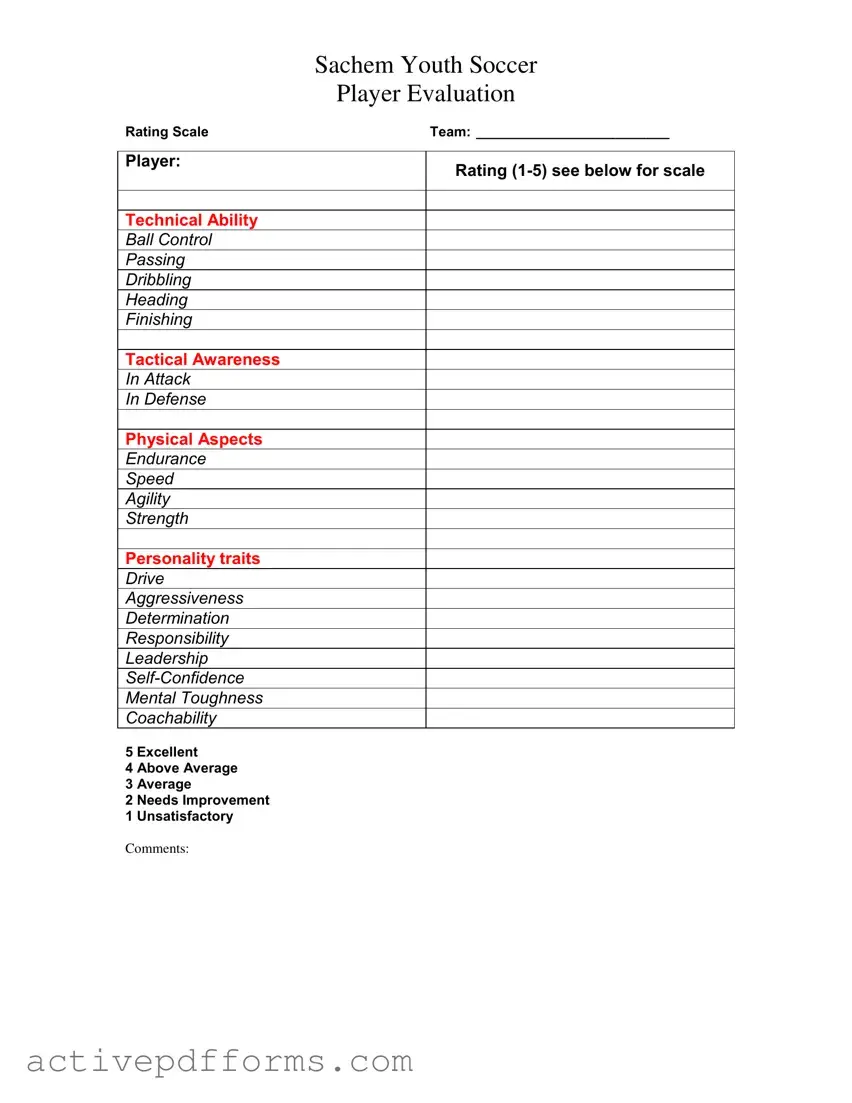Sachem Youth Soccer
Player Evaluation
DEFINITIONS
Technical Ability
Ball Control:
You must be able to bring a ball played to you under control instantly and smoothly. This is the ability to collect and move in a different direction without stopping the ball completely, yet still maintaining it securely. Develop the technique of receiving a pass at top speed. This means not slowing down to collect a ball coming on the ground, bouncing, or in the air. You must be able to protect the ball by shielding it and developing deception in order to get rid of your opponent.
Passing:
You must be able to successfully complete short and long range passes. This incorporates all of your ball skills, including heading, bending, chipping, and the ability to drive the ball to a partner. You will find that at a high level, it is easier to control and make quick decisions with a ball that is driven to you, rather than weakly played. Develop the skill of one-touch passing.
Dribbling:
This is the ability to feint, burst past opponents, change directions and speed at will, and break through packed defensive lines. Can you exhibit quick feet, combined with a sense of comfort under pressure, to penetrate into space to open opportunities for yourself or a partner?
Heading:
The ability to head at goal after crosses, heading high, wide, and deep for defensive clearances, heading balls as a one-touch pass (both into space or to a partner’s feet) in order to create
shooting chances. Can you effectively demonstrate the ability to do this under the duress of the game?
Finishing:
Nothing makes more of an impression on people than the skill of goal scoring. This aspect takes in the correct technique of striking the ball in various ways; driving low balls, hitting volleys, half- volleys, half-chances, chipping, bending, heading, etc.. Good goal scorers can also finish with their chest, heel, toe, and thigh. Coaches are looking for that player who can exhibit composed aggressiveness, swift and secure decision taking at the opportune times. The successful goal scorer has the mentality of a great used-car salesman, very aggressive and not afraid of failure.
Tactical Awareness
Tactical insight incorporates the anticipation, reading, and execution of certain clues that happen during possession and non-possession of the ball.
In Attack:
A. Player not in possession:
1.Makes themselves available for the ball, perhaps by a diagonal run or a crossover run.
2.Realizes when it is crucial to offer close support and when to stay away.
3.Recognizes the proper time to execute “take-overs” and “overlaps”.
B. Player in possession:
1.Has good peripheral vision, recognizing the correct time to switch the ball to the other side of the field.
2.Has good penetrating vision, allowing them to see and utilize players who are far down the field.
3.Recognizes the correct time to play directly, and when it is important to hold the ball (shielding
or dribbling), or when to run at top speed past players opening up passing angles for his team.
4.Sees opportunities to play “one-twos”.
Sachem Youth Soccer
Player Evaluation
During the immediate pursuit, and desire to regain possession of the ball, the player should recognize:
1.When to race forward to intercept the pass.
2.When to mark the opponent tight in order to discourage the ball from being passed to them (pressure).
3.When, where, and how (posture) to tackle.
4.When to jockey the ball carrier and force them away from the goal (patience).
5.The quickest avenue of attack upon regaining the ball.
Physical Aspects
Endurance:
The ability of a player to commit themselves diligently throughout the game in attack and defense with no sign of fatigue and impaired ball control. That player must constantly be running into open spaces demanding the ball or pulling and committing opposing players to create openings. Even though this is also a tactical commitment, it will only be successful if you have the endurance capabilities to run for 60 to 90 minutes. The coach will be examining your physical exertion as you are being exposed to tactical problems you are trying to solve in the game.
Speed:
The ability to accelerate quickly and maintain that acceleration of the various lengths that player’s position demands. As an example, the forwards need acceleration with changes of speed over three to twenty yards. Elements include:
1.Pure straight-ahead running speed.
2.Lateral speed (changing direction).
3.Change of speed (slow to fast, fast to half speed).
4.Deceleration (“stopping on a dime”).
After these basics are attained, speed must be practiced with the ball!
Agility:
The ability to change directions quickly. Twisting, turning while dribbling, readjusting your body to control an awkwardly bouncing ball, and getting up quickly after a tackle are a few examples. This area is enhanced by flexibility exercises such as stretching, ball gymnastics, and skill training with the ball. Conditioning training must be combined with skill and tactical training!
Strength:
The ability to effectively use your body to win physical confrontations. Strength is exhibited during tackling (1 vs. 1), winning the aerial duel (heading), and changing directions effectively (explosion). It is also important to learn how to effectively use that strength to your advantage as is demonstrated in using your arms to hold a player off while running at top speed with the ball or in shooting for power. Much of your strength and power training can be combined with technique training!
Sachem Youth Soccer
Player Evaluation
Personality traits
Each coach loves to identify key players with personalities and qualities that cause them to become team leaders. The following personality traits are the most recognizable:
1.Drive: Pure will power, eager to achieve goals, a burning desire to achieve success, strong self-motivation, commitment, dedication, determination.
2.Aggressiveness: “Go-getter”, strong self-assertions, takes risks, wants to dominate opponents, works hard and ruthless in attack and defense, Danger - bad losers, inclined to retaliation and revenge fouls, loses self-control, general lack of discipline.
3.Determination: Seeks the direct way towards goal, no compromising, doesn’t hesitate when making decisions, willingness, fully concentrated, success oriented.
4.Responsibility: Intelligent, can read the game tactically (anticipation), conscientious, reliable, wants security, cooperative, ready for compromise, stable and skillful player.
5.Leadership: Intelligence, dedication, pride, bears responsibility for the team, influences the environment, anticipation, intuition, independent and spontaneous, convincing and dominating player, hard worker, no surrender, composed, self-controlled, endurable, communicative, respected, trustful.
6.Self-Confidence: Secure ball control and determined application of skills and tactics under pressure (both external and self-imposed). Danger - these players tend to underrate opposing players, show a lack of willingness to be coached, and can become easily complacent.
7.Mental Toughness: Persistency, consistency, and commitment throughout the game, no surrender, tough self-assertion.
8.Coachability: Ready to learn and to achieve goals, self-motivated, attentive and receptive, willingness, interested, spontaneous, committing themselves, likes to discuss problems, hard worker, self-disciplined, creative, constructive, progressive.

